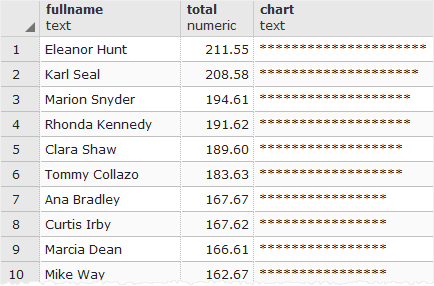In this tutorial, you have learned how to use the PostgreSQL LPAD () function to pad characters on the left of a string to a certain length. Please note that for each of the example below, we have included single quotes around the result to demonstrate what the lpad function returns in PostgreSQL. Fill up the string to length length by prepending the characters fill (a space by default). The problem is that rpad truncates the string when it is actually longer than number of characters to pad. Padding zeros to the left in postgreSQL.
Note: Before PostgreSQL 8. Those coercions have been removed because they frequently caused surprising behaviors. PostgreSQL で文字列を0埋めしたい時は 「 lpad ()」か「rpad()」を使うといい。 第一引数の文字列を、第二引数の文字数分、第三. In this PostgreSQL post explains how to use the PostgreSQL lpad function with syntax and examples. The PostgreSQL lpad function returns a string that is left-padded with a specified string to a certain length.
Open Graph and plain old meta-tags. One single generic SQL Left Pad string function (LeftPad) maps to either a built-in LPAD function or its emulation with a SQL expression. Example 1: PostgreSQL RPAD() function: In the example below, the 1st parameter within the argument is string i. What does the LPAD function do in Postgres SQL?

We use PostgreSQL ’s LPAD function to “pad” a string with a specific number of characters to obtain a resulting pre-determined string (text) length. As we’ll see in our second example below, sometimes we want to pad numbers with zeros in order to obtain uniformity. In SQL Server, you can use an expression using RIGTH, REPLICATE and LEFT functions to get the same result as Oracle.
However, SQL Server (or more precisely, T-SQL), doesn’t include these functions. So if you need some left padding, you’ll need to improvise. Postgresql - função LPAD Neste artigo, vamos mostrar exemplos, da utilização da função LPAD.
Utilizamos a função LPAD para completar uma string do lado esquerdo com determinado(s) caractere(s). PostgreSQL also provides versions of these functions that use the regular function invocation syntax (see Table 9-7). In PostgreSQL, it doesn’t cast the integer to a text string before calling the LPAD function.
In PostgreSQL , it doesn’t cast the integer to a text string before calling the LPAD function. I have a problem, I have a function in postgres , to generate headers that will be used to generate a more complex report. For the structure of the. Introduction to PostgreSQL TRIM function The TRIM() function removes the longest string that contains a specific character from a string.
By default, the TRIM() function remove spaces (‘ ‘) if you don’t specify explicitly which character that you want to remove. PostgreSQL 常用函数 PostgreSQL 内置函数也称为聚合函数,用于对字符串或数字数据执行处理。 下面是所有通用 PostgreSQL 内置函数的列表: COUNT 函数:用于计算数据库表中的行数。 MAX 函数:用于查询某一特定列中最大值。 MIN 函数:用于查询某一特定列中最小值. Ce résultat démontre bien que le prix peut être formaté de la façon désirée grâce à la fonction LPAD(). Il n’est pas dur pour un programme informatique de supprimer les zéros initiaux pour retrouver le prix sous un format plus facile à exploiter.
The PostgreSQL rpad function returns a string that is right-padded with a specified string to a certain length. LPAD (str,len,padstr) Returns the string str, left-padded with the string padstr to a length of len characters. If str is longer than len, the return value is shortened to len characters. The LPAD() function isn’t limited to just zeros. As mentione it can be used to pad any string with any other string.
So you can pad a number with leading 1s, or leading letters, or other symbols if required. It works on PostgreSQL, should work with MySQL. В этом учебном пособии вы узнаете, как использовать в PostgreSQL функцию lpad с синтаксисом и примерами.
Описание Функция PostgreSQL lpad возвращает строку, дополненную с левой стороны указанной строкой определенной длины.
Keine Kommentare:
Kommentar veröffentlichen
Hinweis: Nur ein Mitglied dieses Blogs kann Kommentare posten.